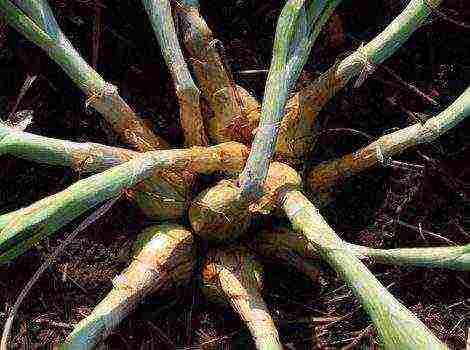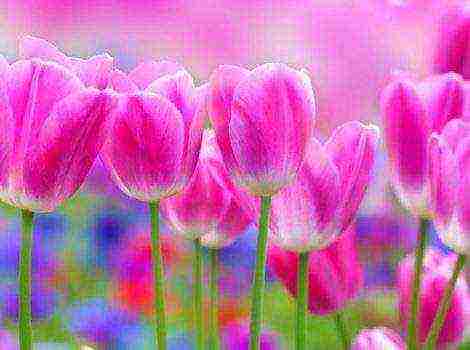Content [show]
Hosta halcyon is a hybrid variety of tardiflora x sieboldiana “Elegans, which has the second name“ Calm ”. A short shrub about 50 cm tall with bluish-gray foliage, covered with a thin, very persistent, indelible silvery waxy coating that helps the plant retain moisture. It simultaneously decorates the bush and serves as protection from the sun's rays, unintentional mechanical damage to the leaves. This variety is an excellent representative of the blue host group, growing excellently, retains the color of the leaves well throughout the season.
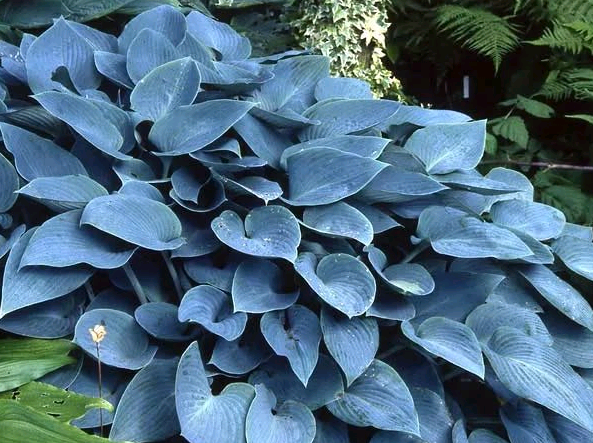
Description of hybrid hosts
The host plant, cultivar halcyon (trade name for the host tardiana halcyon), stands out from the rest of the host for the deep blue of large leaves of a heart-shaped configuration. On peduncles, almost non-leafy, 70-80 cm high, funnel-shaped flowers with a characteristic purple tint bloom. A fragrant bloom lasting about three weeks occurs in July-August.

Landing site hosts Halcyon
A correctly chosen place of the blue hosta variety in the garden will delight those around you with a luxurious color of foliage, abundant and long flowering. Features of landing hostsa blue:
- Wet areas of the garden, prolonged drought has a negative effect on the plant;
- The soil should be loose, with a large supply of nutrients, since plants can grow without replanting for 20 years;
Important. Spring mulching around hosta outlets with humus or compost provides the roots of a perennial plant with the necessary moisture and nutrients.
- For planting hosts, you should avoid areas where moisture stagnation is possible, you need to provide good drainage for planting blue hosts;
- The plant is demanding on light, prefers areas protected from direct sunlight.
If the halcyon hosts meet all the conditions for planting, its flowers will acquire a deep blue color. They will be a great addition to the landscape of coniferous trees, among the fern thickets.
Planting rules for the blue hosta variety
Khosta hybrid halcyon is planted and grown according to the same principles as the entire genus of these plants: partial shade, nutritious, with low acidity, well-moistened drained soil.
Hosta planting time is spring or autumn. The main stages of planting:
- The planting hole should be sized according to the volume of the seedling roots;
- The root system is freely placed in the prepared hole (a small amount of organic and mineral fertilizers must be poured onto its bottom);
- The hole is covered with the selected soil, which is compacted so as to prevent a large number of voids around the rhizome;
- After watering, it is imperative to mulch the root collar with peat, dry mullein or humus;
- The seedling is watered abundantly with settled water. Young plantings are watered several times at intervals of no more than 4 days;
- Further care of hosta plantings consists in systematic watering, weed removal, loosening, introduction of nutrients,
- Proper watering should ensure that the soil is saturated to a depth of at least 50 cm. On average, at least one bucket of water should be spent on watering one bush of a plant;
- Khosta late halcyon, is highly frost-resistant, but annual mulching before the onset of winter colds increases the survival of the plant in frosty winters with little snow. The mulch layer should be at least 3 cm.
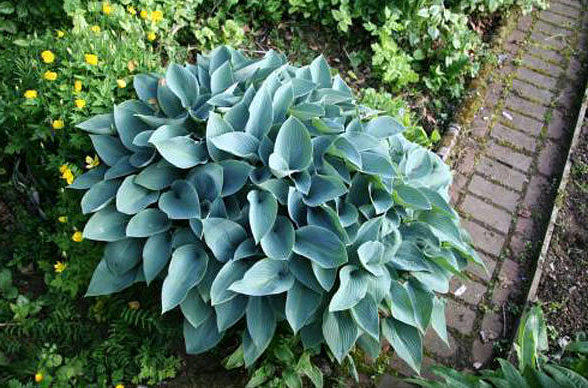
Important. A hybrid hosta variety Halcyon is used in parks and gardens dominated by shade. She is good at single and group plantings. It goes well with plants of various shapes and colors of leaves.
Basic requirements for the care of a blue host
The halcyon host needs the usual rules for caring for this type of plant: feeding, watering, loosening, mulching. Therefore, you need to ensure:
- Proper moistening of the bush will provide the necessary development of the root system. With insufficient moisture supply to the roots, they begin to grow actively only in the upper layers of the soil. In the deeper layers, more powerful roots develop, providing the plant's vitality. As the ambient temperature rises or falls, the roots at the surface may die. The host becomes accessible to diseases and pests;
- To prevent the growth of a hybrid in a dedicated area, use the method of dividing the bush. This option allows you to keep the planting in perfect condition and get seedlings of the selected variety.
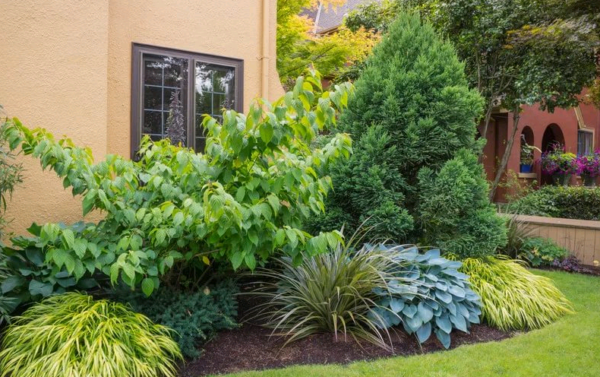
The division procedure is performed in early spring, with the appearance of the first shoots of the plant, or at the end of summer, in the last days of August. Care for the sparse plantings of the hosta halcyon is the same as when it is planted in the ground.
Important. Surface watering of blue hosts is unacceptable. In this case, the water only washes the bush, rolling off it, without moisturizing the plant's root system. In addition, some of the water gets into the rosettes of the leaves, contributing to the development of fungal diseases.
Diseases and pests
Diseases practically do not affect the hybrid, since a sprawling bush with wide leaves does not allow weeds to grow, which are the main source of microorganisms, bacteria, fungi and rot.
The main enemies are slugs, for which the moist earth under the leaves serves as a fertile place for their breeding. They attack the hosta by devouring the succulent stems and leaves of plants. The weevil beetle causes considerable harm.
Particular attention should be paid to young plants, to protect them from the invasion of harmful insects.
Blue hosts in a shady garden landscape
Hosts, with the unsurpassed beauty of blue, dove-blue leaves and compact, dense bush form, serve as an ideal garden decoration next to other ornamental plants and single plantings.

The combination of blue and green host varieties is used to decorate the borders and the line of the shore of the reservoir. The rock gardens and shady garden are decorated with large and miniature host varieties in various shades.
Hosta is a popular plant with a dense rhizome. It can often be seen in shady courtyards and parks. This perennial with large foliage can become the highlight of a flower bed, decorate a summer cottage or garden. The blue hosta has an unusual blue-gray foliage.Even florists use it to create unusual bouquets. The host is loved by landscape designers and is often used to decorate flower beds.
Characteristics and description of the plant
The blue hosta is a ground cover plant and can protect itself and neighboring cultivated plants from weeds. In its natural environment, it grows in the Far East, Korea and China. It is considered sacred to the Japanese and has been cultivated in gardens for thousands of years. Previously, the tradition did not allow residents of eastern countries to import the host abroad, therefore in Europe they learned about this perennial only in the XVIII century.
The blue host looks very unusual. Its leaf is heart-shaped and large enough. An interesting blue-green color to the leaf plate is given by a wax coating. It becomes less visible when exposed to sunlight. The plant blooms in September. In the photo of the host, a plant with bright foliage, in a blooming state, seems to be a real queen of the garden. Inflorescence - bells collected in a brush of lilac, white or lilac color. Bloom lasts from June to October. When all the buds wither, the peduncle must be removed.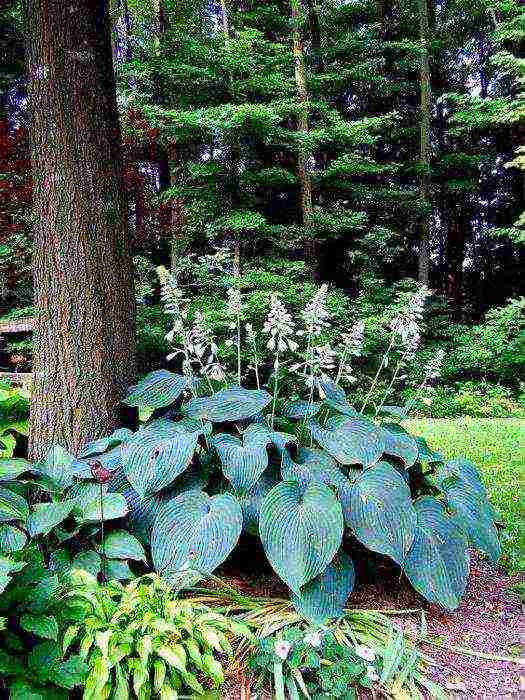
Using hosts in landscaping
Hosts are versatile plants for shady areas. They get along well with most plants and are undemanding to care for. The plant is not picky about the soil and tolerates the lack of light well. Hosta is combined with ferns, aquilegia, lungwort, astilba and other flowers. The composition of this perennial and coniferous plants, as well as group planting next to fountains, artificial waterfalls or around a pond, has a special charm. Thanks to the many varieties, you can use your creativity and combine different plant forms with each other, coming up with unusual combinations. Different varieties of blue host and low green shrubs look good together. Large bushes are often planted on curbs and paths, combining them with tall plants. Beautifully flowering perennials beautifully set off the unusual color of the leaves of the blue hosta. You can grow the hostu as a container plant by moving it around the garden.
Blue hosta: planting and care in the open field
Planting hosts in the spring begins with the selection of a place. When planted in a sunny area, the leaves lose their bluish tint and become just green. Therefore, you should choose partial shade. Perennial prefers places under the crown of large plants or trees. Where to plant the blue host? It develops poorly on sandy and loamy soils. The ideal soil is slightly acidic and moist, but a thick layer of drainage should be placed in the planting hole. A place for the plant should be chosen protected from drafts. When planting in groups, the distance between the plants should be at least 80 cm. Water them only at the root, otherwise the leaves can be damaged.
Planting pit preparation
Before planting hosts in the spring, the soil must be loosened 30 cm deep, and then mixed with a complex fertilizer to stimulate the growth of the root system. Then the soil is removed, a small hole is dug, twice as wide as the root system of the plant. The root collar should be flush with the soil when planting. The roots are straightened during planting, after which they are covered with soil. The earth is rolled up, mulched with bark, the blue hosta is watered abundantly.
Top dressing hosts
The plant acquires a decorative appearance in the third year of life. The leaves turn blue at two years old. In fertile soil, it will be necessary to feed a perennial no earlier than a year after planting. In autumn, it is enough to cover the soil around the plant with compost. If the plant lacks nutrients or it grows in poor soil, fertilizer is used for feeding in granules, scattering it around the bush.
You can feed the blue hosta until mid-summer, otherwise it will only increase the green mass, and not bloom, and will not have time to stop growing before the frost begins. The soil around the plant is constantly moistened so that the foliage retains its decorative effect and does not begin to darken around the edges. Watering should be done in the early morning, lifting the foliage. Then the ground is mulched - this will allow you to retain moisture inside. To make the perennial look neat and not lose its shape, young peduncles are removed. In late autumn, the leaves are cut: new ones will appear in the spring.
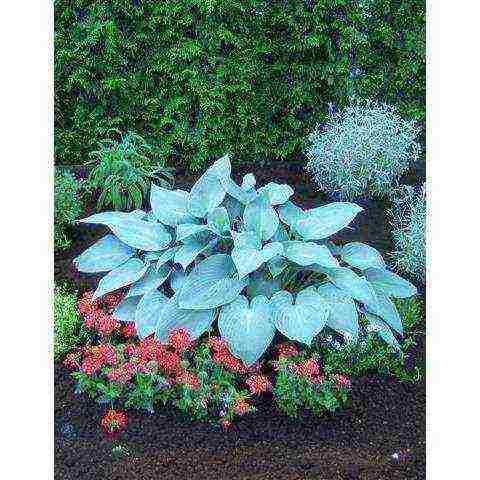
Blue host varieties
In the photo of the host, the plant is blue, often stands out against the background of other perennials. Therefore, landscape designers love to use it for their work. This perennial has many interesting varieties, and several different blue hosts can be planted in the garden at once.
The classic varieties include:
- Halcyon is a bush with embossed heart-shaped leaves, up to 50 cm high. Flowers are of a lavender shade. Prefers partial shade, but withstands a sunny location.
- Blue Angel is a large plant, up to 90 cm high, with a 40x30 cm leaf. Prefers partial shade. The leaves are corrugated, very large, with a bluish bloom. The flowers are like hyacinths, lavender in color, and have a pleasant scent.
- Love Pat is a slow growing bush with dense blue leaves. Height - 60 cm, lavender flowers.
- Blueberry Ala Mode is a blue hosta with a white border around the edge of the leaf. The name translates as "blueberry ice cream". The bush is medium in size, leaves are rounded, corrugated.
- Queen Of The Seas - a plant up to 60 cm high, can grow on the sunny side, flowers do not smell. The leaves are wavy, with denticles at the edges, dense and beautiful.
- Canadian Blue is a Canadian blue hosta, a compact variety. The size of the bush is 30x40 cm.
- Parisian Silk is a short but wide bush that prefers a shady location. The foliage is round, silvery blue. It blooms for a long time, with pink bells.
- Smoke Signals - the bush is distinguished by upward-looking pointed leaves. Can grow in direct sunlight.
- Blue Mammoth is a large plant with very beautiful wide rounded leaves.
- Neptune is a cultivar with unusual pointed, corrugated foliage. Loved by pests, especially slugs.
- Blue Dolphin - heart-shaped leaves with deep veins.
- Pewterware is a bush with dense, gray-green rounded leaves.
- Big Daddy, or Big Daddy, is a blue hosta variety, according to the description of which it can be seen that it belongs to one of the strongest and most hardy. It can be up to a meter wide and 60 cm high. The leaves are rounded, wrinkled, very dense and matte. Develops slowly, prefers shady areas. In a sunny location, the leaves lose their color a little.
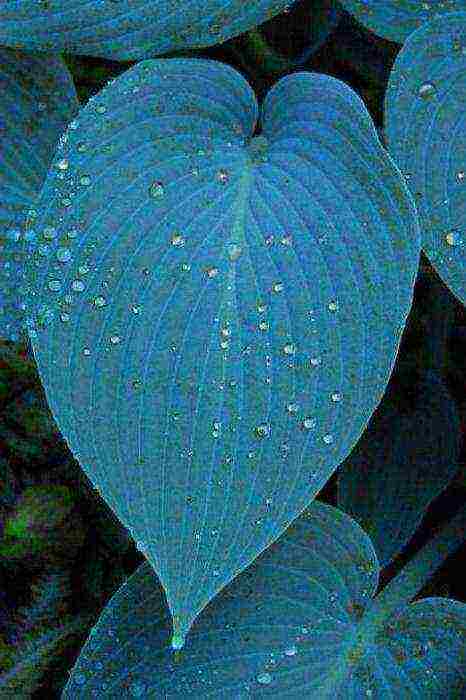
Reproduction of blue hosts by dividing the bush
Reproduction of blue hosts is possible by dividing the bush, cuttings and seeds. The bushes are divided during transplantation in the fifth year of the plant's life. This allows them to maintain their shape. The best time for separation is early spring or early fall. The host dug up and cut the rhizome, leaving one or two sockets on each plot. The cut points are sprinkled with crushed charcoal. Damaged and rotten roots are removed, and the plants are planted in a permanent place. Hosts usually take root within two weeks. Therefore, it is advisable to have time to plant them before the temperature drops.
Cutting hosts
Propagation by cuttings allows you to preserve the plant variety. This method is used in the summer, from June to July. Shoots with leaves are used as cuttings. The sheets should be shortened by one third to reduce the evaporation of moisture from the surface. The cuttings are sheltered from direct sunlight and constantly moisten the soil around.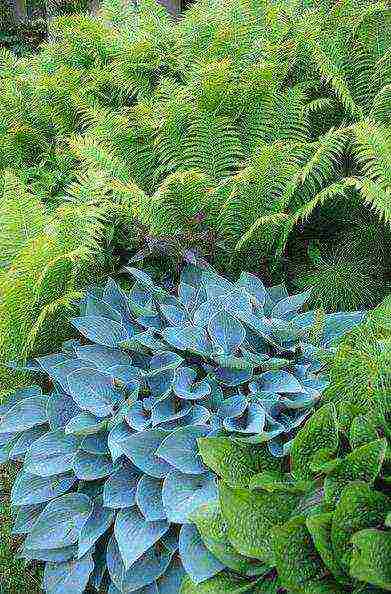
Seed propagation
Seeds appear after the plant has faded. In place of the buds, a box remains from which the seed can be collected.The disadvantage of this breeding method is the loss of the variety. Hosta seeds do not differ in strong germination; before sowing, they are soaked in growth stimulants and treated with a pink solution of potassium permanganate. The soil is also disinfected to destroy fungal spores and other pathogens of various diseases. You can do this by calcining the soil in the oven or by treating it with the same potassium permanganate solution. Soil for sowing seeds is made up of baking powder and peat. It should be breathable and lightweight. The host is sown superficially into moist soil using disinfected containers. A thick layer of drainage is placed on the bottom. The seeds are lightly sprinkled with a substrate, covered with foil or placed in a greenhouse and placed in a place protected from direct sunlight.
Seedling care
The optimum temperature for seedlings is + 20-25 ° C. The first seedlings appear after 2 weeks. Then the greenhouse is transferred to a well-lit place and periodically ventilated, accustoming the plants to an open space. It is important to monitor the moisture content of the soil and not allow it to dry out. At the stage of the first pair of leaves, the seedlings are picked by placing them in different containers. The pots are placed in a large tray of water and watered through it. The top layer of the soil is covered with sand and the moisture is monitored. When young plants get stronger, they begin to harden, lowering the air temperature to +18 ° C. Hosts develop very slowly and almost always lose varietal qualities when propagated in this way.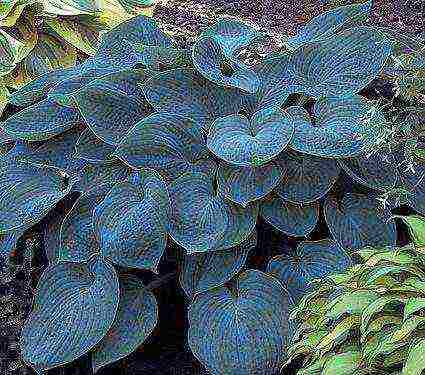
Pest hosts
The blue hosta is most commonly damaged by snails and slugs. They eat the succulent leaves and spoil their appearance with their silvery footprints. The main means of dealing with them are traps and bait in the form of granules. Small rodents can spoil the rhizomes. To protect it, it is better to squeeze it in a container with a net or scatter poisonous bait around it. Pests especially often attack the host in winter. If the plant does not have fresh leaves in the spring, this may indicate that insects have damaged the root. To check, it is dug up and examined.
Hosta does not need special shelter for the winter, but some experienced gardeners try to protect themselves by mulching the soil around the plant. If the soil is damp, these places are ideal for breeding field mice. They dig holes around and spoil the root system of the plant. Caterpillars are another danger to blue hosts. They can destroy a bush overnight. Special chemicals are used against these insects - insecticides. A dangerous pest that destroys hosts is a nematode. These worms live in the ground, but can crawl onto plants and feed on leaves. Lesion marks appear as brown streaks on leaf veins. Aphids can also settle on the blue host. Then small spots appear on the leaf plate, similar to pin punctures.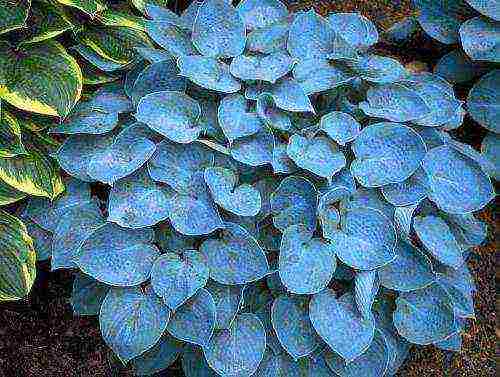
Diseases of hosts
Among the common diseases of these perennials, fungal ones are in the first place. They are fought with fungicides. Plants can become infected with viruses. Signs of damage are yellow spots and dots on the leaf plate. It is useless to fight viruses, the diseased plant is dug up and destroyed, otherwise the virus will spread to neighboring trees and shrubs. An instrument that has come into contact with a diseased plant must be disinfected.
Phylostictosis is a disease caused by a fungal infection. It is often found in perennials weakened by heavy wintering and when the top freezes during recurrent frosts. The lesion marks look like large merging brown spots with a grayish coating.
Blue hosta can also get anthracnose. The infection affects plants weakened by a lack of nutrition and an excess of moisture in the soil. The disease can be cured with systemic fungicides.
The host genus belongs to the Asparagus family.These are perennials with overall decorative foliage of various colors, effectively merging with garden compositions formed by decorative flowering plants. In nature, there are about 40 host species, but their hybrid forms and varieties are most in demand in horticulture.
The highest degree of popularity of a host is determined not only by the beauty of their leaves, but also by longevity - individual bushes are able to decorate a garden or flower garden for 25 years, and moreover, their splendor and beauty increase with age.
Host varieties and species
One of the most commonly used species in horticulture is host Siebold from the island of Honshu (Japan). This plant is characterized by dense, broadly cordate-ovate leaves, covered with a waxy, bluish bloom. Their length is no more than 35 cm, and their width is up to 25. Flowers in the form of white funnels, 5-6 cm long are located on rather long (up to 40 cm) peduncles.
Old Japanese hybrids of this species are often found in gardens, especially the variety hosta aureomarginate with leaves bordered by a wide dark yellow edging.
Another popular type is hosta wavy - has a garden origin, bred in the Land of the Rising Sun. Its leaves are oblong-ovate, elongate 20 cm in length and 13 in width. The edges of the foliage are characterized by strong waviness, and the central part is a combination of white and green areas (the center may be completely white). The shape of the flowers is funnel-bell-shaped, the color is light purple, the length is up to 5 cm. The peduncles of this species rise by as much as 80 cm and have several small leaves.
Variety hosta wavy album belongs to the group of medium size, develops normally in high light conditions. Its dark green leaves are 19 cm long and 9 cm wide with a thin creamy white border. The color of the flowers is dark purple, they are located on even higher (up to 90 cm) peduncles.
Sort hosts
Along with the species and varieties presented above, varietal hosts are widespread, of which today there are more than 3000! Given this number and variety, it is customary in culture to divide them into several garden groups.
For example, according to the color of the leaves, hosts are classified as blue, yellow, light-bordered (white or yellow edging), and so on.
- Separately taken hosta blue (like any other), at the same time, falls under the size classification - variety hosta blue cadet belongs to the low.
- Hosta halcyonas mentioned earlier hosta wavy album, to the average.
- White-bordered varieties include a dwarf variety hosta stiletto and middle hosta patriot.
- Hosta Golden Tiara - medium yellow bordered.
- Low hosta june has a yellow-cream center and blue-green edges.
- Hosta Striptease looks very original - the center of a wide dark green leaf is highlighted with a yellow spot with a thin white border.
- Hosta Golden Meadows considered one of the most beautiful due to the corrugated edges of the sheets.
- Hosta guacamole with rounded foliage may have yellow stripes on it.
- Hosta first frost is so popular that in 2010 it earned the title “Host of the Year”- medium in height (up to 35 cm), spreading (up to 90 cm in width), changing the bluish color of the foliage to green.
- Hosta albopicta - medium, very persistent, changes the shade of leaves from yellow with bluish-green edging to 2-tone green.
- Hosta Big Daddy - blue, large, with wafer-textured sheets, exudes a light aroma.
- Hosta Hybrid Jeepsie Rose has foliage with a golden yellow central part and dark green edging.
- Hosta cherry berry - undersized (up to 30 cm in height), with creamy white, dark green at the edges, strewn with light green strokes of leaves.
- Hosta Rainbows End - dwarf, with glossy bright yellow foliage with a wide green frame.
- Hosta Wide Brim with a heart-shaped foliage, painted in an emerald green tone, bright yellow at the edges, rather spreading - its height is 60 cm, and its width is 90.
Hosts for our climate
Of all the host varieties that exist today, the most suitable for growing in our climatic conditions are the following:
- Above grade hosta blue cadet... Its bush is about 15 cm high and up to 50 wide.
- Hosta Brim Cap... Variegated, with green foliage and white edging. Height - up to 30 cm, width - up to 38. It is best to plant in the shade and where there is light for half the day.
- Hosta gold standard... The foliage is ovoid, dark green, golden in the center. Strong growth is characteristic.
- Hosta patriot... The foliage is green with distinct stripes 1–2 cm wide, changing color from creamy yellow in May to white during the growing season.
to the table of contents
Hosta planting and care in the open field
The unpretentious hosta grows well almost anywhere on the site, next to the roots and tree trunk, on damp lowlands, dry slopes. The location is chosen based on the color of the foliage - for varieties with dark green leaves, shading is great throughout the day, since they can develop and bloom even in semi-darkness, while the prevailing majority of varieties are recommended for artificial shade (under fruit trees).
Yellow, lime and light green hosts grow well in areas shaded only during the hottest season. The same is true for the blue group. If there is simply no shade on the site, and it is completely illuminated by the sun, then it is better to plant the host from the west or north side of other large flowers, or water it intensively and mulch the rhizomes with compost.
When planting, it is very important to adhere to the recommended depth: the root collar of a large hosta should be deepened by 4-5 cm, and a miniature or dwarf one - by 1-2. Departures from these norms can be fraught with rotting of the root collar on one side and pushing the plant out onto the soil surface on the other.
Rhododendron can serve as a legend of bright colors compositions with hosts and other plants, although it is rather moody, but it is worth it. When planting and nursing in the open field, rhododendron requires adherence to the rules, you can find recommendations for growing in this article.
to the table of contents
Watering hosts
Hosts, like other plants with large and numerous leaves, tend to evaporate moisture in large volumes, especially in hot weather. The increased moisture content of the soil has a positive effect on the size of the leaves of this plant, and therefore it is recommended to maintain it this way all the time, paying special attention to the areas where young growth is growing.
When watering, maintain a medium-strength stream of water to avoid strong soil compaction. Moisture should saturate the ground to a depth of 10-15 cm. Moistening procedures are recommended to be performed in the morning or evening, on sandy soil - every day. If the host does not have enough moisture, it will signal this by darkening at the tips of the leaves.
to the table of contents
Soil for hosts
For growing hosts, nutritious neutral or slightly acidic soils are preferred. A very heavy clay soil requires the addition of sand and compost, and a poor and dry sandy soil requires leaf humus and peat.
Low and dwarf hosts are extremely sensitive to high groundwater, so they are planted in loose light soil, after mixing sand, fine bark and gravel into it.
to the table of contents
Transplant hosts
Frequent transplants can harm adult specimens, which grow well on a permanent site for more than 10 years. If the need arises, the procedure is performed in the spring or at the end of August - the first half of September.Spring division of the bush and transplanting is not recommended only for the Siebold hosts, her hybrids and Tokudama hosts.
Before planting in a new area (20-30 minutes), it should be watered. Low and medium hosts should be planted within a radius of 20-30 cm from each other, and varieties with large leaves - 30-40. Watering after planting should be daily for at least 14 days.
to the table of contents
Top dressing hosts
Hosts, which are mostly large plants, require good organic fertilizers such as humus and compost to maintain a high decorative effect. The second is flavored with the soil in the pit during planting, sometimes with the addition of complex mineral fertilizers. Dolomite flour or ash should be added to acidic soil.
Regarding mulching, it is worth noting that in the spring it is better to perform it using, for example, humus, mowed grass or semi-decomposed sawdust, and in the fall it will be convenient to repeat it to protect the plant from frost during snowless cold periods.
Mineral fertilizers for host are selected on the basis of nitrogen, phosphorus and potassium (the store mix on the package contains the designation “NPK”) in an equal ratio or 1: 2: 1. For the first application, the time of the beginning of leaf regrowth is chosen, often in April, the second mineral dressing is carried out 6 weeks later - at the end of May, and the final third - in July.
to the table of contents
Pruning hosts
To keep the hosta always well-groomed, you need to break off its young flower arrows. Their appearance leads to the fact that the foliage diverges to the sides, as a result of which the symmetry inherent in the plant before flowering decreases.
But for some species and varieties, the approach in this aspect of care should be different, since, for example, the plantain hosta, its forms and varieties have special flowers - large, white and fragrant. Their peduncles should not be touched until the end of flowering, after which they can be removed.
to the table of contents
Hosta preparing for winter
The preparation of a garden beauty for winter is determined by some of the previously indicated actions, namely, by cutting the peduncles at the end of the flowering period, adhering to the feeding regime (fertilization should not be applied after July), autumn mulching (it does not hurt to add tobacco dust to the mulch layer, which snails are afraid of and slugs), as well as treatment with fungicides (phytosporin protects well against fungi and bacteria). In addition, you can provide a shelter from dry branches.
The use of polyethylene film, roofing felt and other materials impervious to water / air for these purposes is not permissible! Immediately after the end of winter, you should not count on the emergence of seedlings - the host will not rush to appear from the ground, waiting for the constancy of heat. This can lead to some confusion for a novice gardener, who may decide that the plant has not survived the cold times, but hosts often emerge late, after which they pleasantly surprise with rapid and rapid growth.
to the table of contents
Growing a host from seeds
Reproduction of hostas by seeds is not recommended, since the development of seedlings in this case is slow - only after 4 years new plants become decorative. Better to use the division of the bush or cuttings.
to the table of contents
Reproduction of hosts by dividing the bush
Hosts belong to those rare species of perennial plants, the rhizome of which can be successfully divided throughout the season, but, again, as indicated in the description of the transplant procedure, it is optimal to do this in spring and early autumn. In the course of division, the foliage is partially removed in order to reduce evaporation.
The separated element is planted in the soil at the same level as it was before, and watered abundantly. Young leaves should appear soon. It is not recommended to divide highly decorative hosts that have not reached the age of 5-7 years, since they do not have time to fully consolidate on the site and fully manifest their varietal potential (all the subtleties of coloring).
to the table of contents
Hosta propagation by cuttings
Reproduction is also possible using stem cuttings, of which a lot is formed in the process of dividing the bush. Parts of rhizomes with buds are planted in a greenhouse, and, in a fairly short time, they become young bushes.
to the table of contents
Diseases and pests
The host is usually not amazed by almost anything, except, perhaps, slugs, which are dangerous for varieties with thin delicate foliage. These molluscs sprinkle holes in the sheets of sheets overnight, and to prevent this, specialized agents, such as a slug eater or a thunderstorm, are scattered over the surface of the earth.
Rarely, but still, the host can be attacked black weevil... In this case, there is yellowing and wilting of foliage... Similar symptoms accompany infection with X or HVX viruses (yellow ring-shaped spots are formed). In both cases, diseased plants must be removed from the site.
If hosta has stopped growingand her leaves brighten and die off, then we are talking about rot of the root collar. The very first signs of the disease indicate the need to dig up the affected bushes and cut out the damaged tissue. The wounds formed on the rhizome should be sprinkled with fungicides, and the cured bush should be planted in another area. It is also recommended to replace the soil at the old place.
The hosts can dry foliage due to illness rust... This ailment is more characteristic of the yellow-bordered host. It is a consequence of dehydration of leaf tissues in hot and dry weather, therefore host varieties of this group are planted only in shaded areas and watered abundantly in dry times.
to the table of contents
For the design of the garden plot to be original, it is important to think over the choice of plant species. Flowers delight with their beauty only during the flowering period. And I want the garden to be attractive all season. Therefore, it is worth growing also decorative deciduous plants, for example, hostu. What is the garden host, what varieties are presented, how to cultivate it, the article will tell.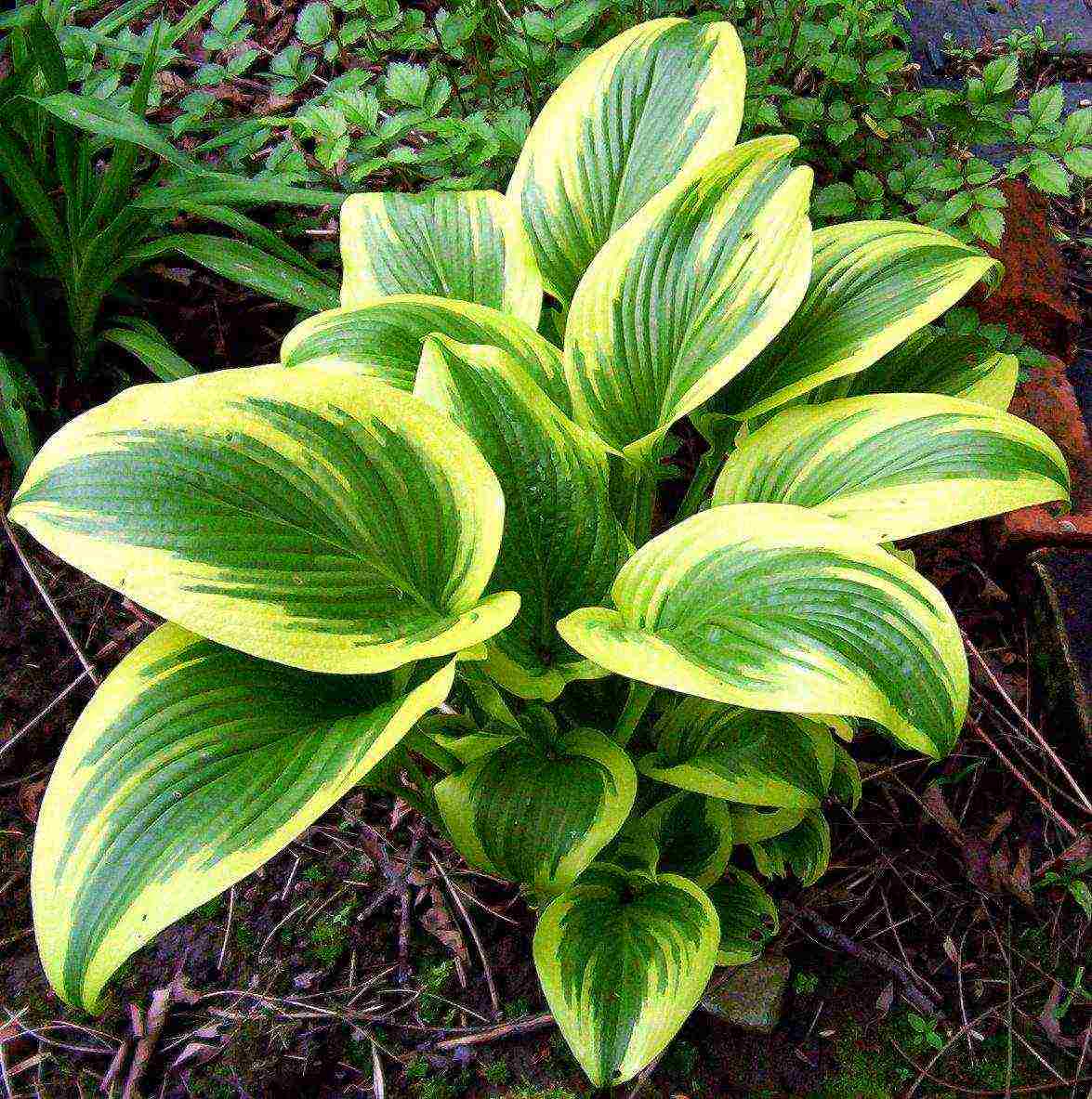
Characteristics of the hosta plant
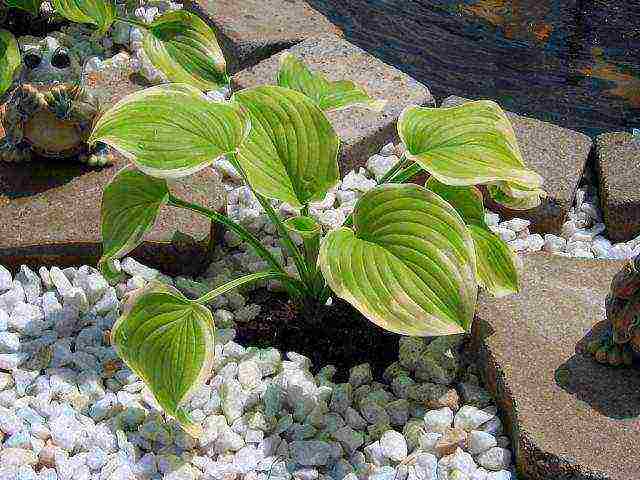 Hosta has a great advantage over other plants. It is characterized by the presence of many species and varieties, which differ in size, shape, color of leaves and inflorescences. By combining different hosts in the garden, you can bring to life the most daring design solutions and create original compositions.
Hosta has a great advantage over other plants. It is characterized by the presence of many species and varieties, which differ in size, shape, color of leaves and inflorescences. By combining different hosts in the garden, you can bring to life the most daring design solutions and create original compositions.
The blooming host does not look very impressive. During this period, nondescript buds are formed. They are collected in a panicle and are on a high peduncle. Bell-shaped. They grow in the form of decorative brushes. But most of all gardeners are attracted by the lush green mass. Therefore, the plant is recognized as an ornamental deciduous plant. Greens pleases before the arrival of frost. You can read an article about growing the best varieties and hybrids of vervain from seeds.
Classification and types of culture
The whole variety of varieties is divided according to two parameters: the size and color of the foliage. Depending on the size, dwarf, miniature, small, medium, large and giant hosts are distinguished. The height varies from 10 to 70 centimeters. As for color, there are hosta blue, yellow, green.
The following types of hosts are also distinguished:
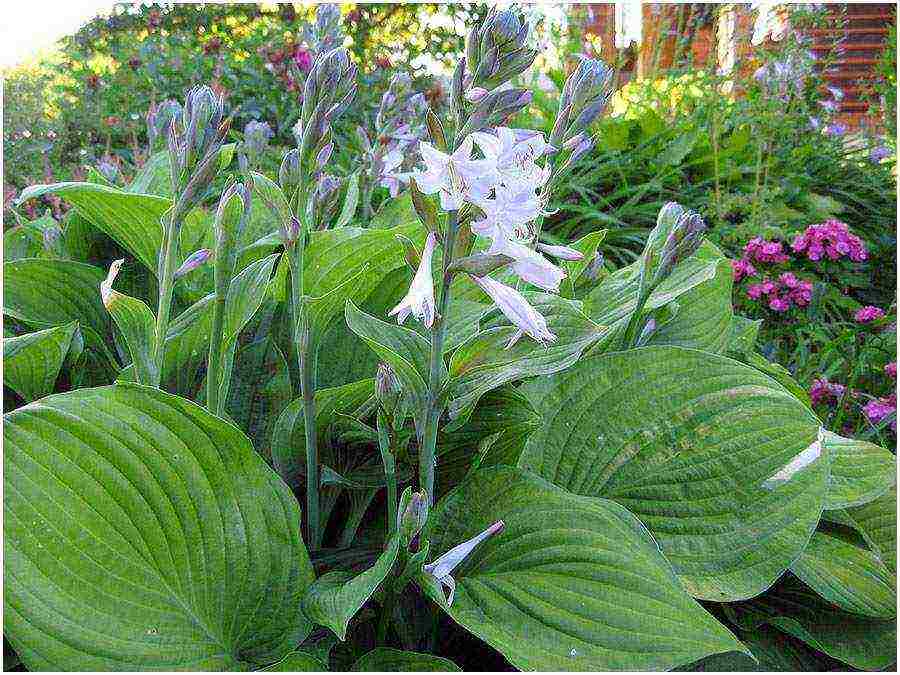 Plantain. It is a fairly large plant. Its height is 70 centimeters. The leaves are thin and rounded. Their color is bright green. The surface is glossy. There are pronounced streaks. The peduncle is long. Large white flowers are formed on it. The buds are dense, short. The flowering period falls on the month of August. Hosta plantain differs in many varieties.
Plantain. It is a fairly large plant. Its height is 70 centimeters. The leaves are thin and rounded. Their color is bright green. The surface is glossy. There are pronounced streaks. The peduncle is long. Large white flowers are formed on it. The buds are dense, short. The flowering period falls on the month of August. Hosta plantain differs in many varieties.- Bloated. It has almost round foliage of a dark green hue. The bush usually grows up to 80 centimeters. Peduncles are high - about a meter. The inflorescences are purple, small and loose. Dissolve at the end of July.
- Fortune. Foliage can be of any green color. Its shape is ovoid. The length is 13 centimeters. There is a waxy coating. The peduncle is quite high and strong. Fortune blooms in August with purple funnel-shaped inflorescences.
- High. Possesses long cordate leaves. They are dense and wavy at the edges. The shade is dark green. The peduncle is short. The buds are dense, light lilac. Blossom in June.
- Wavy. A small plant with long and wavy leaves.The middle is white. There are white-green stripes along the edges. Peduncle length is 80 centimeters. Inflorescences are loose, bell-shaped, light purple.
Which planting variety should you choose?
Although hosts are recognized as ornamental deciduous plants, among them there are often specimens that simply fascinate with their spectacular flowering.
At the same time, the buds exude a very pleasant aroma, similar to the smell of acacia, lilac or jasmine. Consider the currently most popular varieties.
Host Invisible
Characterized by the Invincible hosta with rounded-elliptical leathery leaves. The edges are slightly wavy. There are numerous peduncles. The buds are bluish-white. They are bell-shaped. The culture feels great both in partial shade and in the sun. The shrub reaches a height of 50 centimeters. Blooms in July-August.
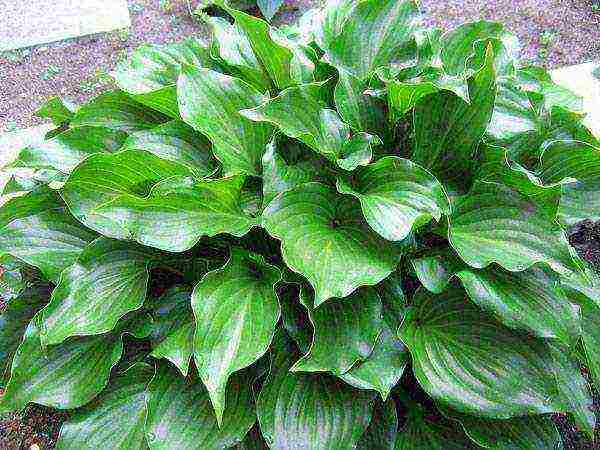
Host Invisible
Hosta White Feathers
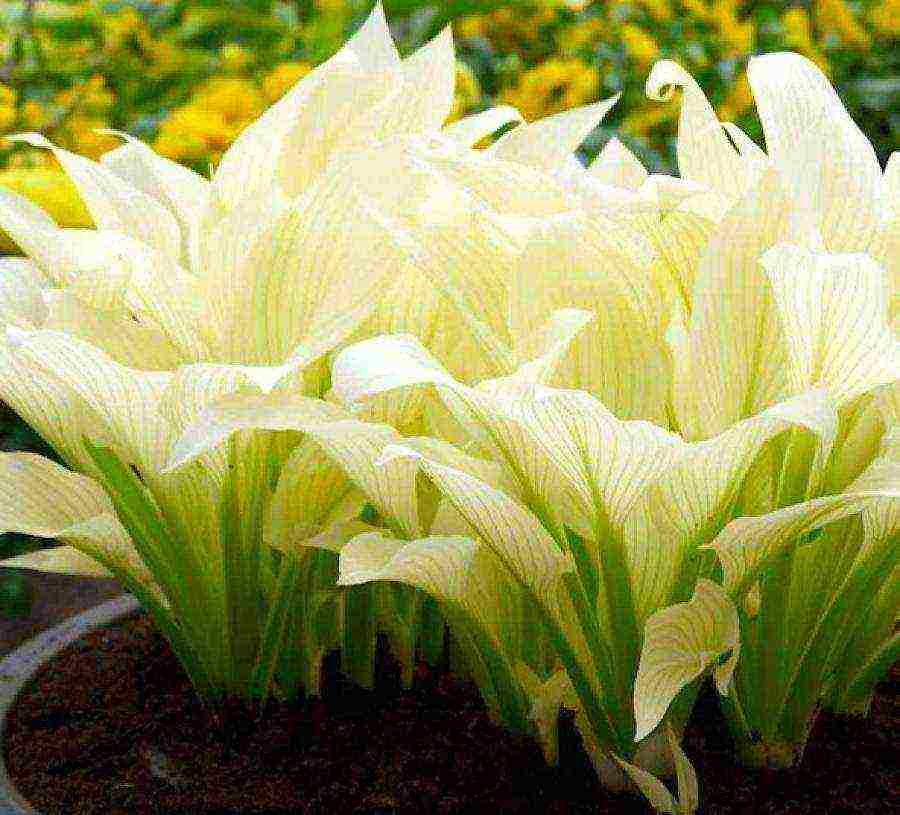 It is one of the spectacular hybrid forms. Young leaves of a creamy white tone. But as they grow, bright green stripes form on them, filling almost the entire leaf plate over time. The size of the sheet is about 15 centimeters.
It is one of the spectacular hybrid forms. Young leaves of a creamy white tone. But as they grow, bright green stripes form on them, filling almost the entire leaf plate over time. The size of the sheet is about 15 centimeters.
The height of the bush reaches 55 centimeters. Inflorescences are lavender. Their color is white. The care of the host White feathers differs in simplicity. After all, the plant is unpretentious, highly resistant to shade, frost, and most diseases. Also, the culture is undemanding to the composition of the soil. No cropping is needed.
But in order for a beautiful and healthy white host to grow up: planting and care must be carried out according to certain rules. It is preferable to choose a place in partial shade. Wet soil is suitable, no stagnant water. White feathers respond very well to feeding. Especially for minerals, humus and compost.
Hosta Albomarginate
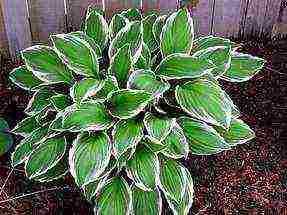 The host Albomarginate stands out for its fast growth and compactness. Bushes grow up to 50 centimeters in height. Covered with large leaves of a dark green tone. A narrow, bright white border runs along the edge. The leaves are lanceolate, corrugated. Length 15 centimeters. Peduncles reach a height of 35 centimeters. They are thin and straight. Several small leaves grow on them. Inflorescences are racemose and loose. Length 6 centimeters. Shade of lilac-violet. Dark stripes are visible. The edges of the petals are strongly bent back. Bordered with a white stripe.
The host Albomarginate stands out for its fast growth and compactness. Bushes grow up to 50 centimeters in height. Covered with large leaves of a dark green tone. A narrow, bright white border runs along the edge. The leaves are lanceolate, corrugated. Length 15 centimeters. Peduncles reach a height of 35 centimeters. They are thin and straight. Several small leaves grow on them. Inflorescences are racemose and loose. Length 6 centimeters. Shade of lilac-violet. Dark stripes are visible. The edges of the petals are strongly bent back. Bordered with a white stripe.
For abundant flowering, it is important that the planting of Albomarginate hosts is carried out correctly. The plant is unpretentious in the content, withstands low temperature and shade. Diseases are practically not susceptible. True, the flower is very picky about the composition of the soil. Care involves regular watering, weeding, loosening, fertilization.
Hosta Patriot
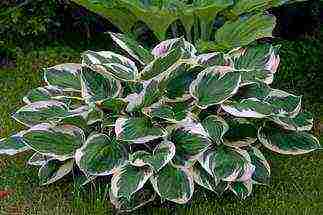 The height of the Patriot reaches 60 centimeters. The foliage is dark green, about 16 centimeters long, wavy. The edges are jagged. There is a white border. Winter hardiness is high enough. The plant is shade-tolerant and unpretentious. However, in order for a consistently blooming Patriot host to grow: planting and care should be carried out taking into account some recommendations. It is advisable to choose a fertile, moist soil. The culture needs to be weeded, irrigated, fed and loosened regularly. Shown is the annual autumn mulching.
The height of the Patriot reaches 60 centimeters. The foliage is dark green, about 16 centimeters long, wavy. The edges are jagged. There is a white border. Winter hardiness is high enough. The plant is shade-tolerant and unpretentious. However, in order for a consistently blooming Patriot host to grow: planting and care should be carried out taking into account some recommendations. It is advisable to choose a fertile, moist soil. The culture needs to be weeded, irrigated, fed and loosened regularly. Shown is the annual autumn mulching.
Hosta Aureomarginate
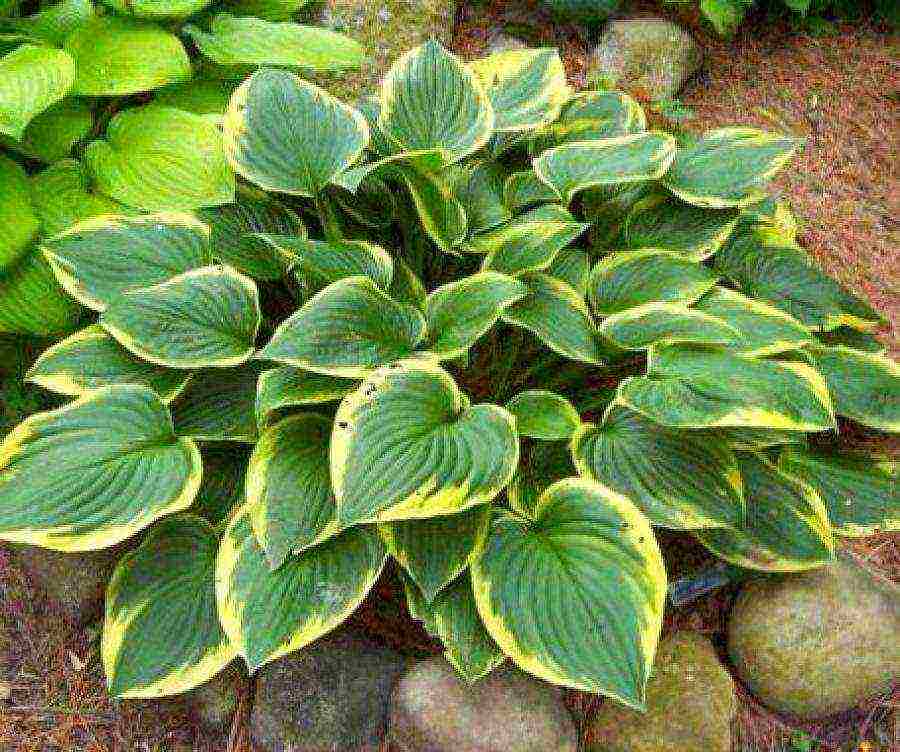 The variety is characterized by dense dark green foliage with a bright yellow thin border. The length of the leaves is 20 centimeters. They are flowing. Bell-shaped buds, painted in lavender tone. Diameter 6 centimeters.
The variety is characterized by dense dark green foliage with a bright yellow thin border. The length of the leaves is 20 centimeters. They are flowing. Bell-shaped buds, painted in lavender tone. Diameter 6 centimeters.
The rhizome is shortened, thick. Has a cord-like shape. Aureomarginate grows up to 50 centimeters. This variety is considered unpretentious. Calmly tolerates the cold, is able to develop well in the shade. Practically not susceptible to disease. But still, so that the luxurious host Aureomarginata grows on the garden plot: planting and care play an important role. The soil should be chosen fertile. It is necessary to ensure the correct irrigation regime. Timely apply fertilizers and loosen the soil.
Hosta Canadian Blue
The variety is densely leafy. Over the years, forms a dense cushion of the bush. The height reaches 50 centimeters. The length of the leaf is 15 centimeters. During the flowering period, lavender buds appear. They are located on high peduncles. If you know all the features of the Canadian Blue host: landing and leaving will be carried out competently. The plant tolerates shade well. Often, the variety is chosen for decorating hedges and the perimeter of houses.
Hosta Mediovariety
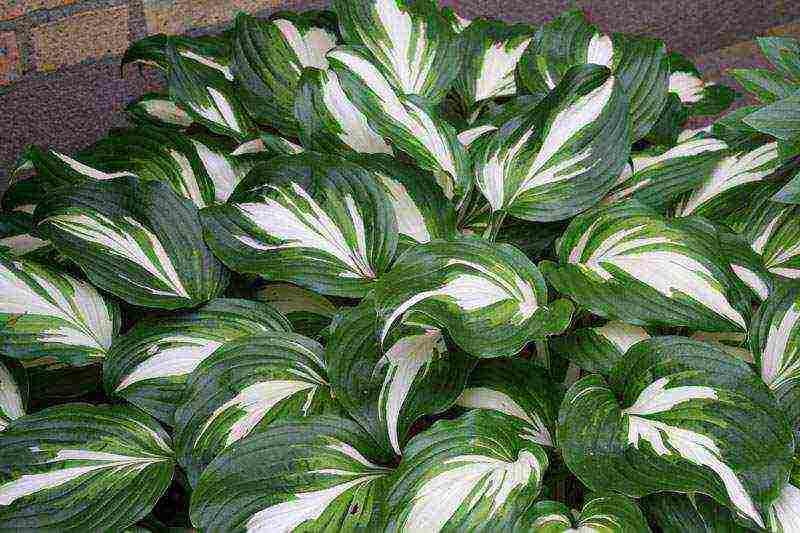 Hosta is a wavy Mediovariegata one of the most beautiful garden varieties. Leaves are medium in size. Twisted a little. They are light green with white inclusions. The flowering is quite early. The buds are pale blue. When unfolded, the diameter is 3 centimeters. Each peduncle contains several small flowers. The host does not have the aroma of the Mediovariety. The shrub grows up to 70 centimeters in height.
Hosta is a wavy Mediovariegata one of the most beautiful garden varieties. Leaves are medium in size. Twisted a little. They are light green with white inclusions. The flowering is quite early. The buds are pale blue. When unfolded, the diameter is 3 centimeters. Each peduncle contains several small flowers. The host does not have the aroma of the Mediovariety. The shrub grows up to 70 centimeters in height.
Hosta Antiochus
 This is a hybrid form. It has a short and compact rhizome. Basal leaves. Located on petioles. Largest in size. Their color is bluish-gray or green. The form is broadly ovate or narrow-lanceolate. Peduncles are practically devoid of foliage. They are large, sometimes reaching 120 centimeters in height. Inflorescences are funnel-bell-shaped or funnel-shaped. Presented in lilac, white, purple colors. Collected in a brush. A culture can grow in one place for about 20 years. The main thing is that the Antioch hosts are planted in moist, acidified soil.
This is a hybrid form. It has a short and compact rhizome. Basal leaves. Located on petioles. Largest in size. Their color is bluish-gray or green. The form is broadly ovate or narrow-lanceolate. Peduncles are practically devoid of foliage. They are large, sometimes reaching 120 centimeters in height. Inflorescences are funnel-bell-shaped or funnel-shaped. Presented in lilac, white, purple colors. Collected in a brush. A culture can grow in one place for about 20 years. The main thing is that the Antioch hosts are planted in moist, acidified soil.
Hosta Chalcedony
 It is a compact bush Chalcedony host. The leaves are medium-sized, bright blue. The variety blooms with purple buds. The foliage is dense and heart-shaped. Covered with longitudinal deep grooves. The color is blue-green. There is a silvery waxy coating.
It is a compact bush Chalcedony host. The leaves are medium-sized, bright blue. The variety blooms with purple buds. The foliage is dense and heart-shaped. Covered with longitudinal deep grooves. The color is blue-green. There is a silvery waxy coating.
Caring for the hosta Haltsion, it must be borne in mind that the variety prefers semi-shady areas, nutritious and well-drained soil. You should regularly loosen, water, weed the ground. Top dressing is also shown.
Hosta Gold Standard
Gold Standard is popular due to the original golden heart-shaped foliage. Lush shrub. Reaches 70 centimeters in height. Has a high growth rate. It is unpretentious in leaving.
It has immunity to a number of ailments, but still for the successful cultivation of the Gold Standard host: planting and care must be carried out correctly.
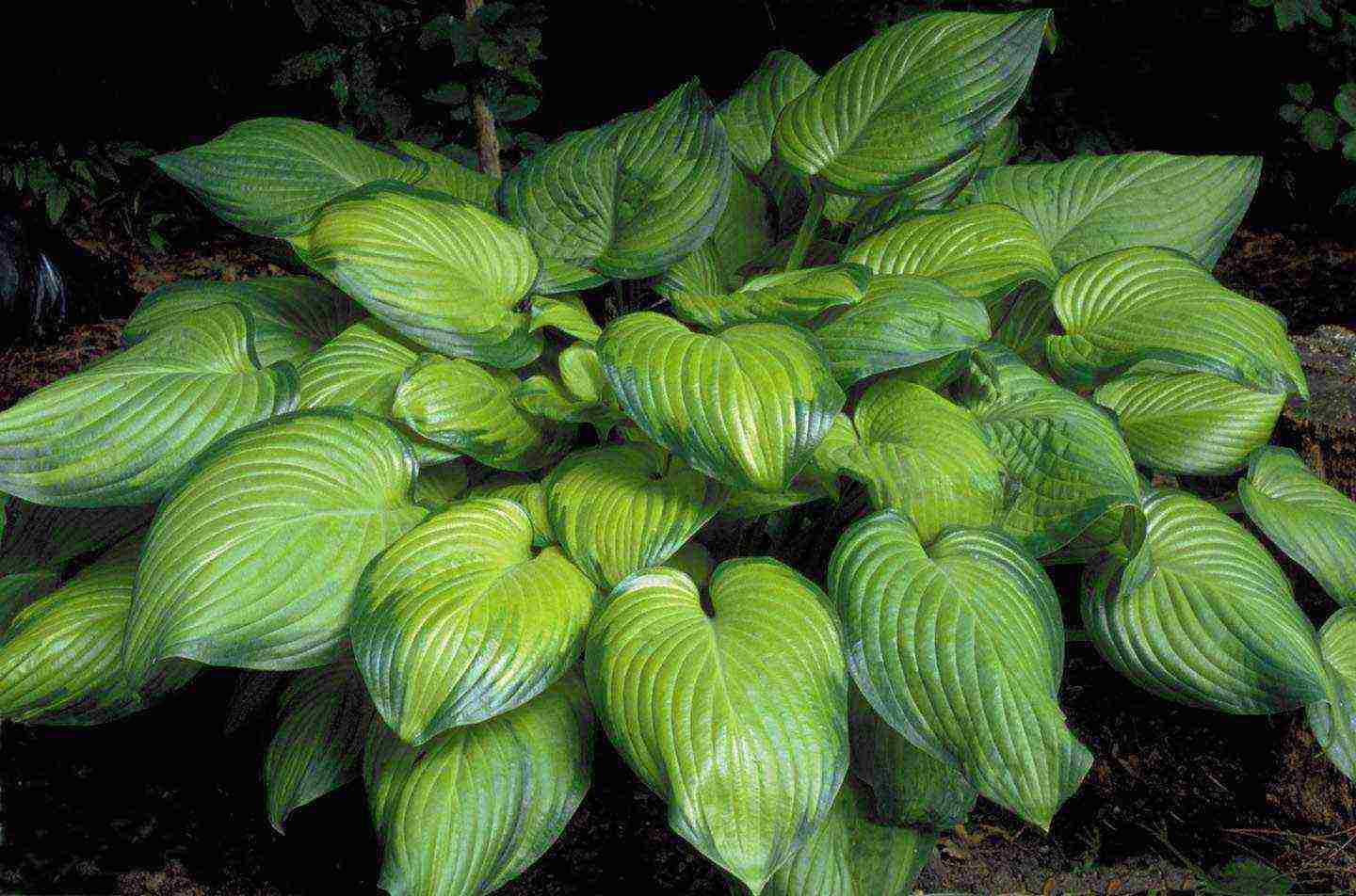 Hosta Guacamole
Hosta Guacamole
Hosta Guacamole is between 70 and 100 centimeters tall. Leaves are medium in size. Their length is 25 centimeters. The color is apple green. The surface is shiny. Inflorescences are pale lavender, exude a pleasant aroma. In one place, the variety usually grows up to 25 years. It is drought tolerant. Loves slightly acidic, drained, moist soil mixtures.
Hosta Wide Brim
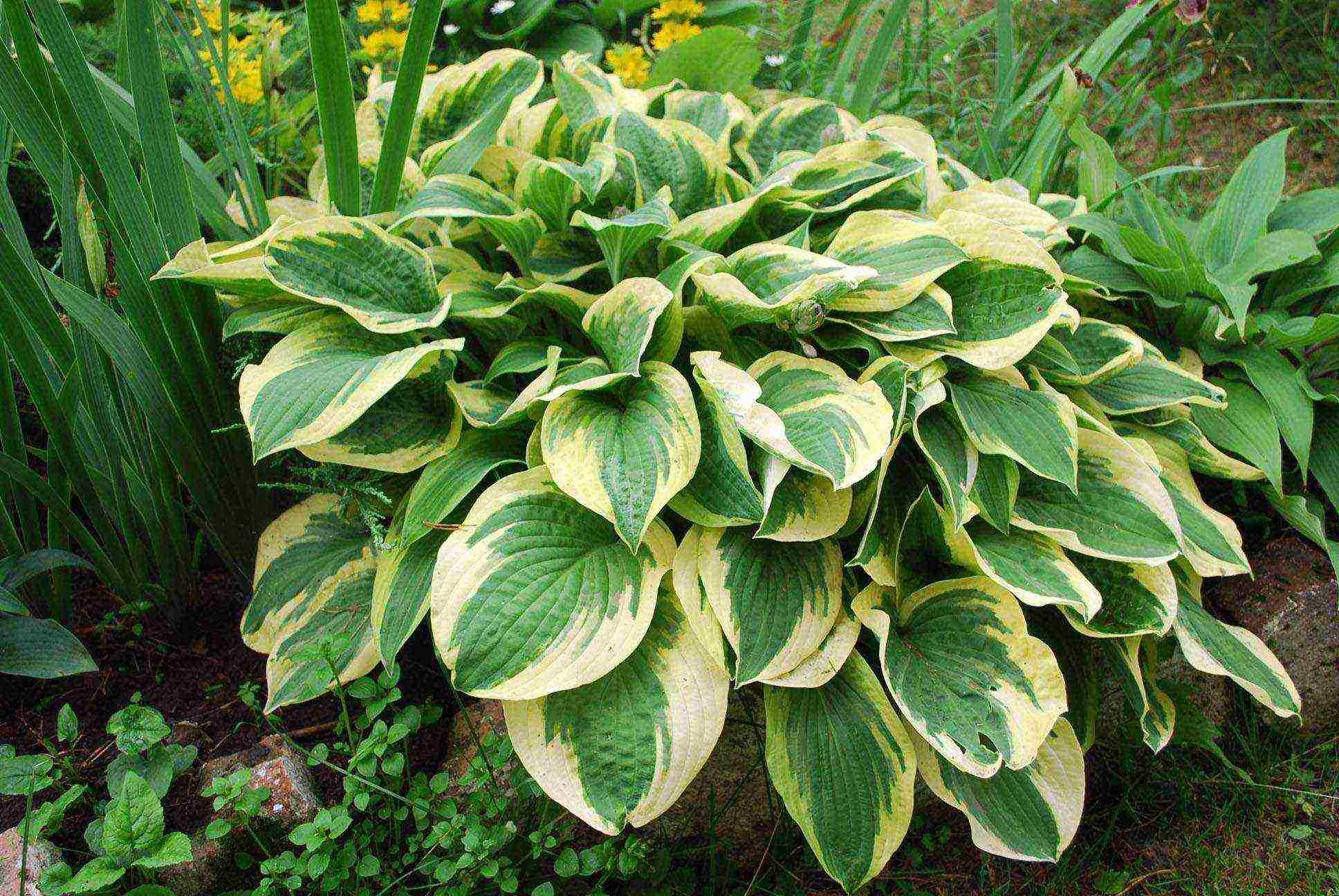 The plant is fast growing, reaching a height of 50 centimeters. It is characterized by the formation of rather large inflorescences, up to 8 centimeters in diameter. They are fragrant, light lavender. The foliage is heart-shaped, blue-green with a creamy wide border. The length is 21 centimeters. Wide Brim is winter-hardy, shade-tolerant and not capricious. But still, for the abundant flowering of the Wide Brim host: planting and care play a decisive role. The soil should be chosen fertile, moist. Irrigate several times a day with an interval of 3 days. Weeding, feeding and loosening are also carried out.
The plant is fast growing, reaching a height of 50 centimeters. It is characterized by the formation of rather large inflorescences, up to 8 centimeters in diameter. They are fragrant, light lavender. The foliage is heart-shaped, blue-green with a creamy wide border. The length is 21 centimeters. Wide Brim is winter-hardy, shade-tolerant and not capricious. But still, for the abundant flowering of the Wide Brim host: planting and care play a decisive role. The soil should be chosen fertile, moist. Irrigate several times a day with an interval of 3 days. Weeding, feeding and loosening are also carried out.
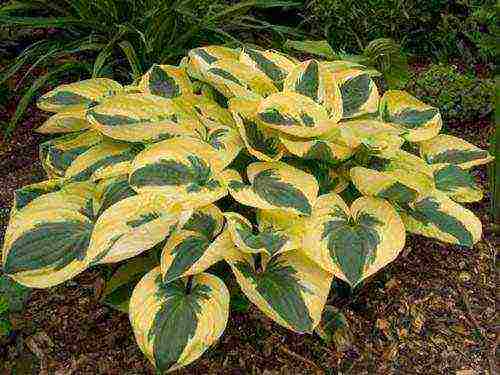 Hosta Brim Cap
Hosta Brim Cap
Hosta variety Brim Cap is distinguished by its low growth and decorative leaves. The height is up to 35 centimeters. The foliage is bowl-shaped, corrugated, dark green with golden edges. Early flowering. The buds are bluish-lilac. But over time they turn white. White varieties look great next to Brim Cap. For example, Hosta Bressingham Blue would be a good option for creating an interesting floral arrangement.
Hosta Cherry Berry
It's a hybrid. The rhizome is short-branched and compact. The bush reaches a height of 25 centimeters.The leaves of the host Cherry Berry are basal, located on petioles. Quite large and thin. There are different colors. The form is broadly ovate or narrow lanceolate. Peduncles are devoid of foliage. The buds are lilac, white, purple. Flowering falls in mid-summer. Prefers sour, moist soil.
Hosta France
Hosta Francais shrub grows about 50 centimeters. The foliage is dark green, wrinkled, with venation. Its shape is heart-shaped. Funnel-shaped buds. Their color is lavender. Peduncle height reaches 75 centimeters. The variety has good winter hardiness and unpretentious care. It is often chosen to create borders, decorate lawns. Often used in the preparation of bouquet compositions.
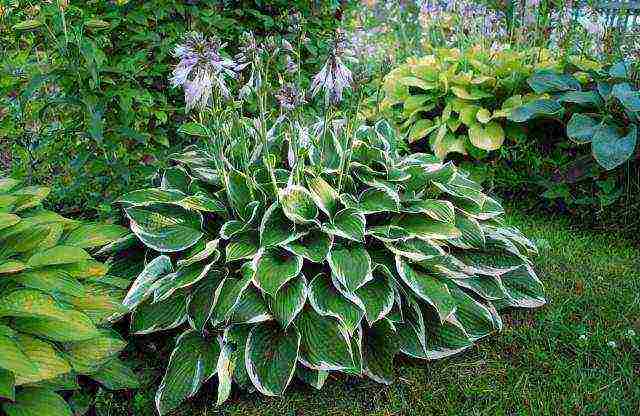
Hosta France
Hosta True Blue
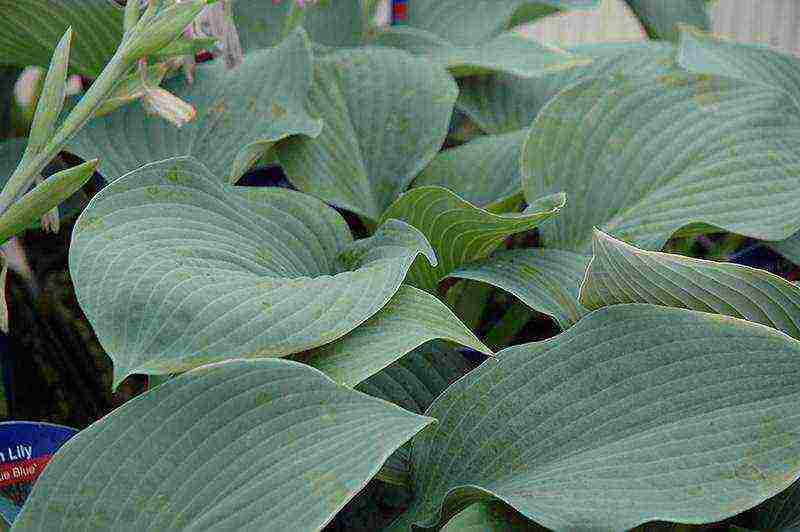 This culture is about 60 centimeters high. The True Blue host is growing pretty fast. The foliage is large, dense, wide-heart-shaped. Its surface is shiny, wrinkled. There is a waxy coating. The flower retains decorativeness for 25 years. Tru Blue is not capricious in its content. Reacts quickly to feeding. Shade tolerant. Looks good on the edges of water bodies, in group and single plantings on lawns.
This culture is about 60 centimeters high. The True Blue host is growing pretty fast. The foliage is large, dense, wide-heart-shaped. Its surface is shiny, wrinkled. There is a waxy coating. The flower retains decorativeness for 25 years. Tru Blue is not capricious in its content. Reacts quickly to feeding. Shade tolerant. Looks good on the edges of water bodies, in group and single plantings on lawns.
Also, gardeners often choose the Blue Ivory host variety for decoration. Such a plant allows you to create a bright accent on the lawn. It is also successfully grown in pots, flowerpots. A good solution is to plant a variety of host Pizzaz, especially if the garden is shady.
How to grow a host?
Every gardener wants to be successful in the cultivation of hosts. This largely depends on the planting material used, knowledge of the characteristics of the variety and experience in the field of floriculture. Consider how hosts are grown: planting and care in the open field, breeding options.
Planting a flower in open ground
To begin with, they are determined with a place. Usually shaded areas, protected from strong winds, are chosen. It is advisable to use the soil fertile, air and moisture permeable. Seedlings are planted in the fall in early September.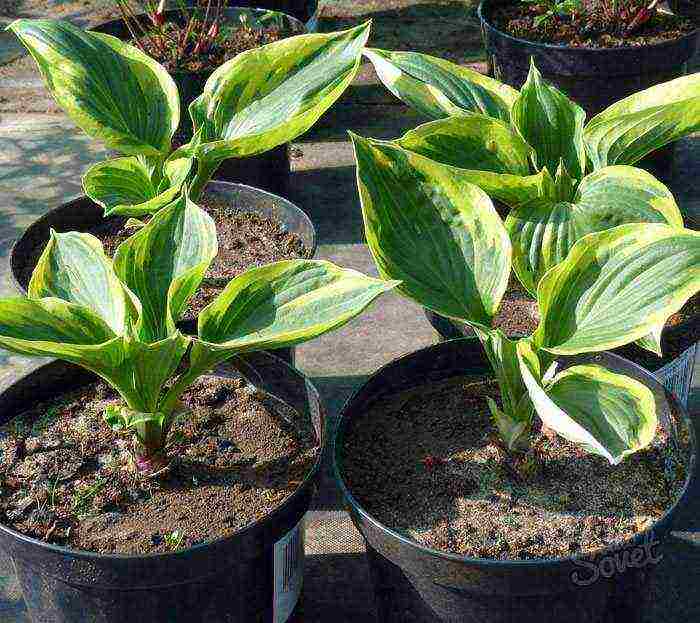
The landing algorithm is as follows:
- They are digging up a garden bed.
- Shallow holes are made at a distance of 50 centimeters from each other.
- A drainage layer is placed on the bottom.
- Fertilizers are applied.
- Planted to the host, spreading the root zone.
- Irrigate abundantly.
- Fall asleep with sawdust.
Plant care
The next step is to arrange for good care. The condition of the plant depends on it. Includes care carrying out a number of activities.
Namely: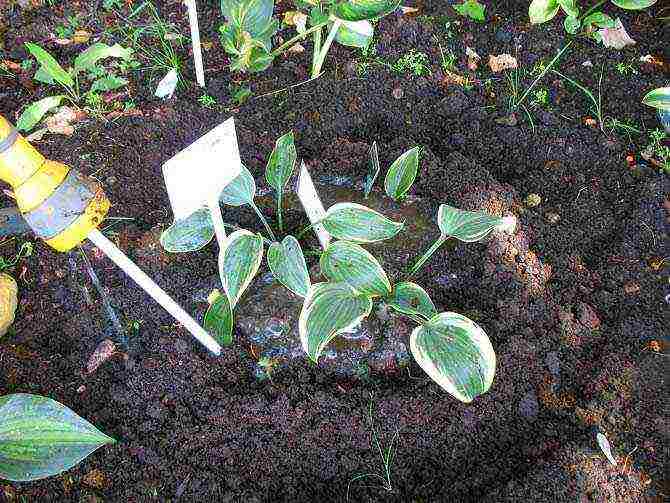
- Watering. It should be frequent and abundant. Irrigate in the morning. It is important to avoid stagnant water.
- Top dressing. Fertilize only if the culture is planted in infertile soil. Nutrients are added three times per season. Use organics and ready-made compositions for decorative deciduous plants.
- Loosening the soil.
- Pruning. Held in the fall. Peduncles are cut off. Leaves are left.
- Transfer. Adult flowers are transplanted annually in the fall.
Plant propagation: basic methods
For growing hostas, seed or seedlings can be purchased at a specialized store. But if someone from your acquaintances already has such a beautiful flower growing on the site, there is a chance to propagate it.
The hosts are multiplied by one of the methods:
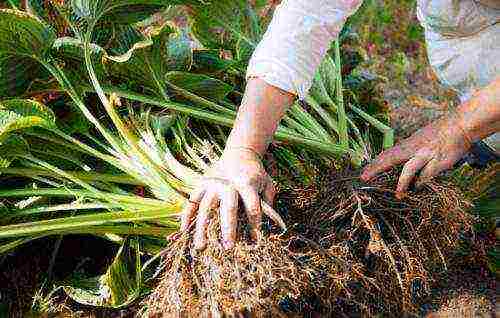 By dividing the bush. Held in April, September. The culture is irrigated before extraction. An adult plant is divided into parts, each of which must contain at least 2 outlets. The shoots are seated at intervals of 40 centimeters.
By dividing the bush. Held in April, September. The culture is irrigated before extraction. An adult plant is divided into parts, each of which must contain at least 2 outlets. The shoots are seated at intervals of 40 centimeters.- Cuttings. Take a process that has a root zone. Planted in the shade. Cover with a plastic cup on top. After a few days, the stalk is transplanted to a permanent place.
- Seeds. Hosta is rarely grown from seeds. Since the germination rate of this plant is low. The seed is soaked in a growth stimulant solution, and then planted in small pots. Cover with foil. Moisturize periodically. Seedlings appear after weeks.
Conclusions about growing hosts
Thus, the hosta is a popular ornamental deciduous plant. There are usually no problems in growing. Especially if the host's landing and leaving were carried out competently. There are many types and varieties of this culture. All of them differ in the shape and color of foliage and inflorescences. You can read the article: Yucca - home care for an unpretentious flower.

